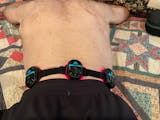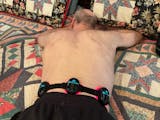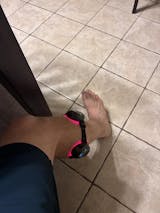Pain behind the knee is something many people experience, but it’s often unclear what causes it. Whether you're dealing with a muscle strain, a cyst, or something more serious like arthritis, pinpointing the issue is essential to getting relief. In this article, we’ll explore common causes of pain behind the knee and how
medical-grade red light therapy devices can help alleviate discomfort and promote healing.
Common Causes of Pain Behind the Knee
Pain in the back of the knee can stem from different conditions, and it’s important to understand these to properly treat the pain.
Hamstring Strain
The hamstring muscles run along the back of your thigh and attach near your knee. If you overuse these muscles—such as from running or sports activities—you may experience a hamstring strain. This can result in a dull ache or sharp pain behind the knee, especially when you try to bend or extend your leg.
Baker’s Cyst
A Baker’s cyst is a fluid-filled swelling that forms behind the knee, often resulting from underlying joint problems such as arthritis. The cyst can cause swelling and a feeling of tightness, particularly when you move your knee. It can be uncomfortable, and the pain usually intensifies after long periods of activity.
Tendonitis
Tendonitis occurs when the tendons at the back of the knee become irritated or inflamed, typically due to repetitive strain from sports or physical activities. The pain may be more noticeable when you bend or stretch your knee and could worsen with overuse. Rest, ice, and the use of medical grade red light therapy devices may help reduce inflammation and aid recovery.
Understanding Baker’s Cyst and Its Impact
A Baker’s cyst is one of the more common causes of pain behind the knee, and it’s important to understand its symptoms and treatment.
What Is a Baker’s Cyst
A Baker’s cyst, also known as a popliteal cyst, forms when the knee produces excess synovial fluid. This fluid accumulates and forms a swelling at the back of the knee. The cyst is often associated with conditions like arthritis or cartilage tears, where inflammation causes the knee joint to produce too much fluid.
Symptoms of a Baker’s Cyst
The primary symptom is swelling behind the knee, which can feel like a lump. This swelling might increase in size after physical activity or when the knee is bent for long periods. The cyst can also make it difficult to fully straighten the leg, causing pain or discomfort during movement.
Treatment for a Baker’s Cyst
For mild cases, conservative treatments like rest and ice can help reduce swelling. In some cases, a healthcare provider may drain the cyst or recommend physical therapy. For chronic pain or inflammation,
medical-grade red light therapy devices - PRUNGO FluxGo can promote healing and reduce discomfort by increasing circulation and decreasing swelling.
Tendon Injuries and Overuse in the Knee
Overuse or strain of the tendons in the knee area is another common reason for pain behind the knee.
Patellar Tendonitis
Patellar tendonitis, or "jumper’s knee," occurs when the tendon connecting the kneecap to the shinbone becomes inflamed. This is typically the result of repetitive jumping or running. The pain is usually felt just below the kneecap but can radiate to the back of the knee as well, especially after intense physical activity.
Popliteus Tendon Injury
The popliteus tendon is located behind the knee and helps with knee movement. When this tendon is overstretched or overused—often during activities that involve running, twisting, or pivoting—pain can occur at the back of the knee. Stretching and strengthening exercises can help, but in severe cases, rest and therapy may be necessary.
Treatment Options for Tendon Injuries
Tendon injuries are often treated with rest, ice, and elevation to reduce inflammation. For more persistent cases, red light therapy devices for home use may be used to promote faster recovery by stimulating tissue repair and reducing swelling around the tendons.
Arthritis and Its Effect on the Back of the Knee
Arthritis can cause pain and inflammation in the knee joint, including the area behind the knee.
Osteoarthritis and Knee Pain
Osteoarthritis is a degenerative joint disease that commonly affects older adults. It occurs when the cartilage in the knee joint breaks down, causing pain, stiffness, and inflammation. This condition can lead to pain in the back of the knee, especially during activities that require bending or standing for long periods.
Rheumatoid Arthritis
Rheumatoid arthritis is an autoimmune disorder where the immune system attacks the synovium in the joints, leading to inflammation. This type of arthritis can affect multiple joints, including the knee. Pain and swelling in the back of the knee are common symptoms of this condition.
Managing Arthritis-Related Pain
For arthritis-related pain, medication, physical therapy, and lifestyle changes are typically recommended. Additionally, using fda approved red light therapy devices can help manage pain by reducing inflammation and improving blood flow to the affected area, promoting healing and comfort.
Knee Injury and Trauma
Direct injuries to the knee can lead to pain in the back of the knee, often caused by ligament or joint trauma.
Torn Ligaments
Ligament injuries, such as torn ACL or PCL, can result in pain behind the knee. These injuries often occur from sudden, forceful movements during sports or accidents. Pain, swelling, and instability are common symptoms.
Knee Dislocations
A dislocated knee is a serious injury where the bones of the knee are displaced, causing extreme pain and difficulty moving the joint. This can result in severe pain behind the knee and requires immediate medical attention.
Recovery from Knee Injuries
Recovery from knee injuries often involves rest, ice, and physical therapy. For more severe injuries, surgery may be necessary.
Red light therapy devices can help speed up recovery by promoting tissue repair and reducing inflammation around the knee joint.
Using Red Light Therapy for Knee Pain Relief
Fda cleared red light therapy has become an increasingly popular treatment for knee pain due to its ability to reduce inflammation and promote tissue healing.
How Red Light Therapy Works
Medical grade red light therapy uses specific wavelengths of light that penetrate the skin and promote healing at the cellular level. This therapy stimulates blood flow, reduces inflammation, and encourages the regeneration of tissues, making it a useful tool for pain management.
Benefits for Knee Pain
For knee pain, red light therapy helps reduce inflammation in the affected area, speeds up the healing process, and can alleviate muscle and tendon pain. By improving circulation, it allows the body to heal itself faster and more effectively.
How to Use Red Light Therapy Devices
Using red light therapy devices is simple and non-invasive. You can apply the light to the back of the knee for about 10–15 minutes per session, a few times a week. Regular use can significantly reduce pain and help with recovery from injuries or chronic conditions.
Conclusion
Pain in the back of the knee can be caused by a variety of reasons, such as muscle strain, arthritis, or even injury. Understanding the root cause of the pain is key to choosing the right treatment. For those seeking non-invasive methods to relieve pain and speed up recovery, medical-grade red light therapy devices are an effective option.
Red light panels are suitable for large-area treatments, while
red light therapy mask focus on facial care, addressing multiple facial areas simultaneously. They are particularly suitable for anti-aging, soothing, and repairing, while also improving skin texture and alleviating acne problems.

























0 comments